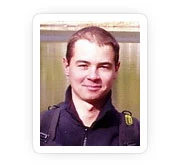Shoulder Biomechanics in Yoga, Part 4: The Deltoid-Rotator Cuff Connection

Foundational knowledge gives you power that you can translate into applications for your yoga practice and teaching.
This blog post will explore some of the essential biomechanics of the shoulder joint, especially the “force couple” between your deltoid muscle and the rotator cuff. Understanding this relationship helps build your fund of knowledge regarding this complex articulation, which can help you later on in developing cues for your practice as well as well as for therapeutics in yoga.
The “force couple” is a biomechanical concept whereby groups of muscles work together around a joint to produce coordinated movement. The force couple between the rotator cuff and the deltoid muscle works in concert with other muscles around the scapula to produce movements such as raising the arm overhead.
The shoulder joint proper is a ball-and-socket joint comprised of the humeral head and its articulation with the shallow glenoid fossa (socket) of the scapula. The bone shapes of the shoulder joint allow for a high degree of motion. Contrast this with the hip joint, where the socket is much deeper and constraining on motion. In addition to the bony stabilizers, there are also soft tissue stabilizers such as ligaments and the labrum and muscular dynamic stabilizers. Figure 1 illustrates the bones of the shoulder.

(Figure 1 – (1) humerus. (2) scapula. (3) clavicle)
Scapulohumeral Rhythm
In the force couple between the deltoid muscle and the rotator cuff, the rotator cuff stabilizes the humeral head against the glenoid fossa. The deltoid muscle then levers the humeral head off the glenoid fossa to raise the arm. At the same time, the scapula and clavicle rotate to aid in producing movement, a process known as scapulohumeral rhythm.
Figure 2 illustrates the subscapularis and infraspinatus muscles acting together to stabilize the humeral head in the glenoid fossa.

(Figure 2 – The Subscapularis / Infraspinatus force couple)
Figure 3 illustrates the force couple between the rotator cuff and the deltoid muscle. Click here to learn about the supraspinatis muscle. As the deltoid contracts to raise the arm, the rotator cuff contracts to stabilize the humeral head in the socket. All of this happens automatically; the brain is hard-wired for this force couple.

(Figure 3 – The Deltoid / Supraspinatus force couple)
Injury to the rotator cuff, such as a tear or inflammation, can lead to less efficient stabilization of the humeral head in the socket. As a consequence, when the deltoid contracts, instead of levering the humeral head off the glenoid, the force of the deltoid contraction causes the head of the humerus to shift upward into the subacromial space. This can lead to impingement of the rotator cuff on the undersurface of the acromion, thus exacerbating the condition.
To compensate, the body uses abnormal movement of the scapula in an attempt to stabilize the humeral head in the socket. This abnormal movement of the scapula on the chest wall is known as “scapulothoracic dyskinesia.” I examine for this by comparing the movement of the normal and injured side from the back while having the patient raise the arms overhead.

(Figure 4 – Raising the arms over the head in Warrior I and Tadasana)
I hope this post helps you build your fund of knowledge regarding shoulder biomechanics.
Would you like more shoulder anatomy & additional practice tips to increase shoulder stability in Downward-Facing Dog Pose? If so, read YogaUOnline’s yoga teacher ed: Dr. Ray Long on Stabilizing the Shoulder in Downward-Facing Dog.
Study with YogaUOnline and Julie Gudmestad – Creating Shoulder Strength and Stability: Serratus Anterior.
Reprinted with permission from the Daily Bandha
 Author Ray Long MD FRCSC is a board-certified orthopedic surgeon and the founder of Bandha Yoga. Ray graduated from The University of Michigan Medical School with post-graduate training at Cornell University, McGill University, The University of Montreal and Florida Orthopedic Institute. He has studied hatha yoga for over twenty years, training extensively with B.K.S. Iyengar and other leading yoga masters.
Author Ray Long MD FRCSC is a board-certified orthopedic surgeon and the founder of Bandha Yoga. Ray graduated from The University of Michigan Medical School with post-graduate training at Cornell University, McGill University, The University of Montreal and Florida Orthopedic Institute. He has studied hatha yoga for over twenty years, training extensively with B.K.S. Iyengar and other leading yoga masters.
 3d Graphic Designer / Illustrator Chris Macivor has been involved in the field of digital content creation for well over ten years. He is a graduate of Etobicoke School of the Arts, Sheridan College and Seneca College. Chris considers himself to be equally artistic and technical in nature. As such his work has spanned many genres from film and television to video games and underwater imagery.
3d Graphic Designer / Illustrator Chris Macivor has been involved in the field of digital content creation for well over ten years. He is a graduate of Etobicoke School of the Arts, Sheridan College and Seneca College. Chris considers himself to be equally artistic and technical in nature. As such his work has spanned many genres from film and television to video games and underwater imagery.



